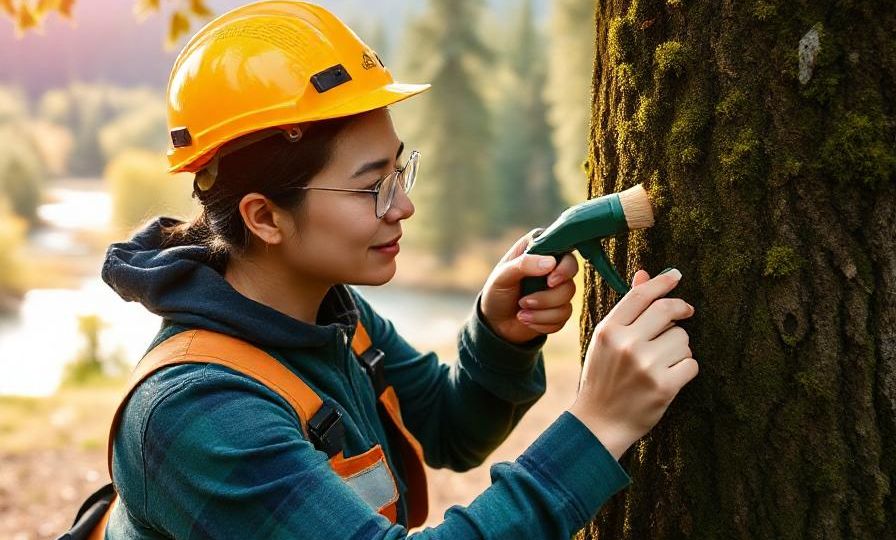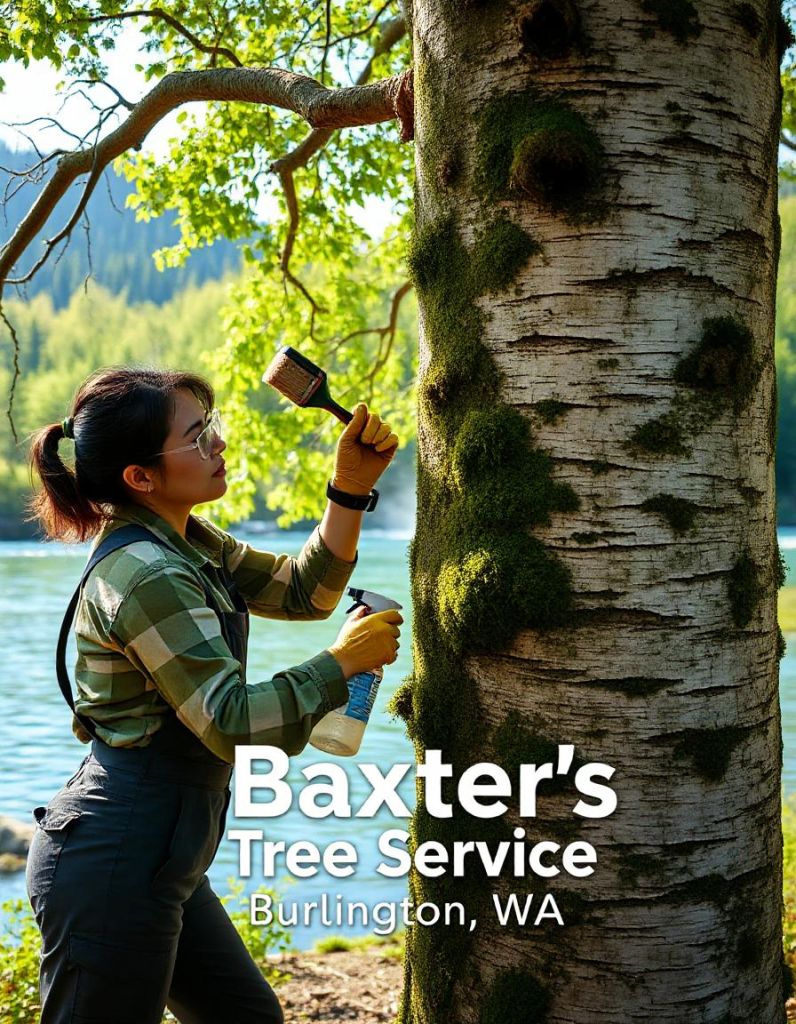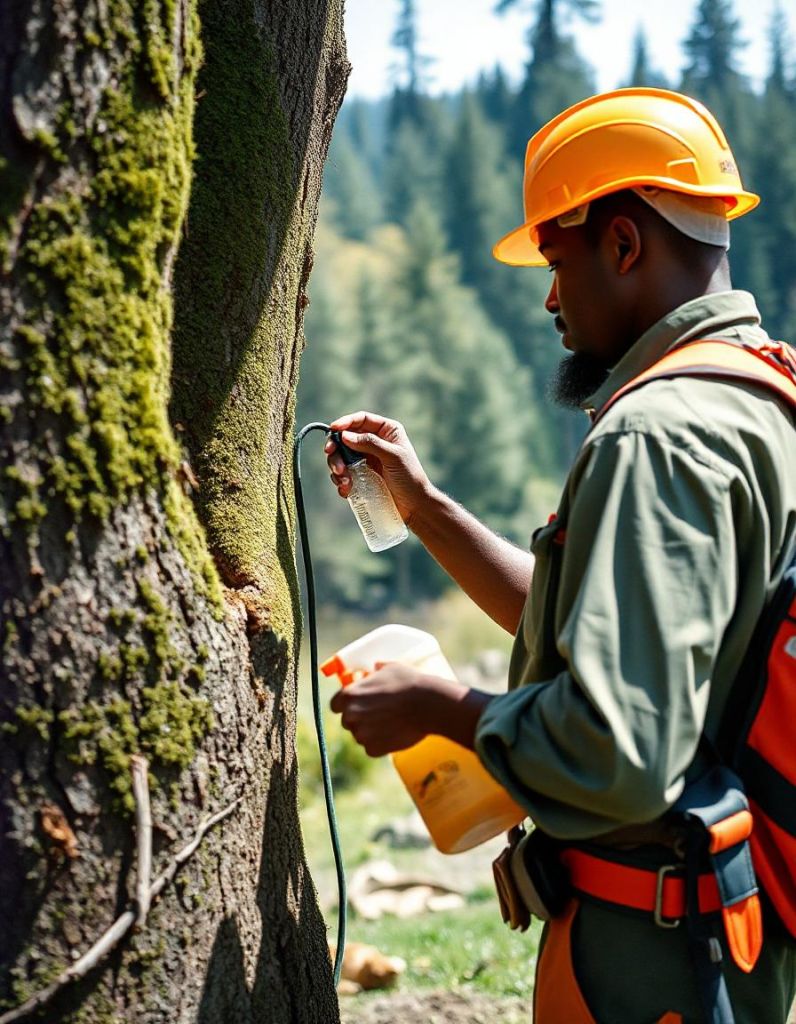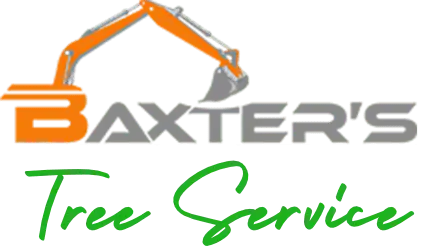
Living in Burlington, WA, or any of the surrounding areas such as Mount Vernon, Bellingham, or Sedro-Woolley, you are likely familiar with the lush green landscape that defines our beautiful region. Our area, known for its iconic Skagit Valley Tulip Festival and stunning natural beauty, is also characterized by a humid climate, which makes it an ideal environment for moss to grow on trees. If you have trees in your yard, whether they are towering evergreens, fruit-bearing apple trees, or decorative palms, you’ve probably noticed moss clinging to the trunks and branches. While moss might add a charming, rustic look to our local parks like Hillcrest Park in Mount Vernon or the famous Big Rock Garden in Bellingham, it can become problematic when it grows unchecked.
In this comprehensive guide, we’ll explore how to remove moss from trees naturally. We will focus on techniques that are effective and eco-friendly, tailored specifically for our local environment here in Skagit County and neighboring Whatcom County. From the beautiful parks of Geneva to the coastal landscapes of Birch Bay, you’ll find practical advice to keep your trees healthy and moss-free.
Understanding Moss Growth in Skagit County
Moss thrives in areas with ample moisture and shade, both of which are plentiful here in the Pacific Northwest. In places like Sedro-Woolley and Sudden Valley, where rainfall is frequent, moss can become a common sight. Understanding the local conditions that promote moss growth is the first step in learning how to remove it. Moss attaches itself to tree bark, feeding off the moisture in the air. It often appears on the north side of trees, where sunlight is less direct, and moisture lingers longer.
Is Moss Harmful to Your Trees?
While moss itself isn’t inherently harmful to trees, it can signal potential issues. In areas around Bellingham or Ferndale, where moss growth is significant, it can retain moisture against the tree bark, leading to decay over time. For fruit trees, such as those you might find in local orchards near Deming, heavy moss growth can reduce sunlight penetration, impacting fruit production and overall tree health. Therefore, managing moss is essential for the health and longevity of your trees, especially in our local climate.
How to Remove Moss from Trees and Shrubs in Burlington and Beyond
Whether you’re in the heart of Burlington or on the outskirts in places like Everson or Lynden, removing moss from your trees can be done effectively and naturally. Here are some methods that work well:
Physical Removal: The Hands-On Approach
One of the most effective ways to remove moss from trees is through physical removal. This method is ideal for Burlington residents who enjoy working in their yards or gardens.
- Tools to Use: A soft-bristle brush or a plastic scraper is perfect for gently removing moss from the tree’s bark. Be sure to visit local hardware stores in Mount Vernon or the Burlington Costco for these tools. If you’re in Geneva or Ferndale, you can find these supplies at your nearest Home Depot or local garden center.
- Best Time for Physical Removal: The ideal time to remove moss is during the late fall or early spring. This is when trees are dormant, and moss is dry and easier to remove. Performing this task during dry weather, which we occasionally enjoy around Skagit County, will make the process more manageable.

Water and Airflow Management: Prevention is Key
Moss thrives in moist, shaded areas. By improving water and airflow around your trees, you can create conditions that are less favorable for moss growth.
- Pruning: Regular tree pruning allows better air circulation and sunlight penetration, crucial for preventing moss growth. Whether you have large oak trees in your yard or smaller ornamental trees, ensuring they are pruned correctly is essential. Consider hiring a local professional service, like Baxter’s Tree Service, which has extensive experience in managing tree health in our local climate.
- Watering Practices: If you have an irrigation system, make sure it isn’t overwatering the base of your trees. Overwatering can contribute to excess moisture, creating an environment where moss thrives. Adjust your watering schedule to meet the specific needs of your trees, especially during the wet seasons we often experience in Burlington and Bellingham.
Best Way to Remove Moss from Trees in Skagit County
Finding the best way to remove moss from trees depends on the type of tree and the extent of moss growth. Here are some locally approved methods:
Using Baking Soda: A Natural Solution
Baking soda is a natural, non-toxic solution that can be used to remove moss from trees. It’s safe for the environment, making it an excellent choice for areas near water bodies like the Skagit River or Lake Whatcom.
- How to Use: Mix one ounce of baking soda with one gallon of water. Spray this mixture on the moss-covered areas of your tree. You’ll notice the moss turning brown and dying within a few days.
- Frequency: Apply the solution during dry weather to prevent it from being washed away. A visit to local stores like the Burlington Fred Meyer or Baxter’s Tree Service can provide you with a bulk supply of baking soda for this purpose.
Vinegar Solution: Another Natural Method
Vinegar’s acidity makes it an effective tool against moss. This method is suitable for homeowners around Sudden Valley or Birch Bay who prefer natural gardening solutions.
- How to Use: Combine equal parts vinegar and water in a spray bottle. Spray it directly onto the moss, allowing it to sit for several hours before using a brush to remove it.
- Precautions: Be careful not to spray the vinegar solution on the leaves or roots of the tree, as it can be harmful. Use it sparingly and target only the moss-covered areas.
How to Remove Spanish Moss from Trees in Western Washington
Spanish moss, although not common, can occasionally be found hanging from trees in our more humid, wooded areas.
Physical Removal: Effective and Direct
Physically removing Spanish moss is straightforward and effective. This approach is particularly useful for residents in areas like Geneva or Deming, where Spanish moss can occasionally appear.
- Using Hands and Tools: Wear gloves and manually remove the Spanish moss. For higher branches, use a long pole or specialized pruning tools. Local garden centers in places like Ferndale offer a variety of tools that can help with this task.
- Best Time to Remove: Removing Spanish moss during dry weather is recommended. Dry moss is lighter and easier to handle, reducing the strain on both the tree brush and yourself.
Tools to Remove Spanish Moss
Using the right tools makes removing Spanish moss more manageable, especially if you’re dealing with taller trees.
- Long-Handled Pruners and Pole Saws: These are ideal for reaching high branches without the need for a ladder. Look for these tools at local hardware stores, or even rent them from equipment rental businesses in Mount Vernon.
How to Remove Moss from Fruit Trees: Keeping Your Apple Trees Healthy
Fruit trees, especially the apple trees commonly found in local orchards, need special care to prevent moss growth.
Pruning and Baking Soda Solutions
Regular pruning and using natural solutions like baking soda are effective in managing moss on fruit trees especially when dealing with emergency tree care situations.
- Pruning: Open up the tree canopy to allow sunlight to reach the interior branches. This reduces the environment moss thrives in.
- Baking Soda Solution: A baking soda solution can be applied to the tree bark and limbs. It’s safe for the tree and helps in naturally reducing moss growth.

How to Remove Moss from Palm Trees: Tips for Our Coastal Areas
Palm trees, which are often planted in coastal areas like Birch Bay and along Chuckanut Drive, require a different approach.
Physical Removal and Regular Maintenance
- Using Soft Brushes: Palm trees have smooth trunks, making them easier to clean. Use a soft brush or scraper to remove moss without damaging the tree’s surface.
- Pruning Dead Fronds: Regularly remove dead fronds where moss tends to accumulate. This simple maintenance helps keep the tree looking its best and moss-free.
Conclusion: Choose Baxter’s Tree Service for Expert Tree Care
Maintaining the health and appearance of your trees is vital for the beauty and safety of your property. Whether you’re dealing with green moss, Spanish moss, or ball moss in your yard, following the natural methods outlined in this guide will help you keep your trees healthy and vibrant. For those living in Burlington, Mount Vernon, or any of the surrounding areas in Skagit and Whatcom counties, you don’t have to tackle this alone.
At Baxter’s Tree Service, we specialize in professional tree care tailored to our local environment. With years of experience serving the Burlington community, we understand the unique challenges of tree maintenance in our climate. Our team is equipped with the knowledge and tools needed to effectively remove moss and other tree-related issues, ensuring your trees thrive. We take pride in our work, offering services that are both environmentally friendly and highly effective.
Whether you need tree pruning, moss removal, or any other tree care service, contact Baxter’s Tree Service today. Let us help you maintain the natural beauty of your property, ensuring your trees remain healthy and strong for years to come. Call us now to schedule a consultation or visit our website to learn more about our services. Your trees will thank you!
FAQ’s
How do I Get Rid of Moss on a Tree in Burlington, WA?
To get rid of moss on a tree in Burlington, WA, you can manually remove it using a soft-bristle brush or a plastic scraper, then apply a natural solution like baking soda mixed with water. These methods work well in the damp climate of Skagit County.
What is the Easiest Way to Remove Moss from Trees in Skagit County?
The easiest way to remove moss from trees in Skagit County is to spray a solution of baking soda and water directly on the moss. This method is safe, effective, and suitable for the rainy weather typical of places like Mount Vernon and Sedro-Woolley.
What Tool is Used to Remove Moss from Trees in Bellingham?
For removing moss from trees in Bellingham, you can use a soft-bristle brush or a long-handled pole saw for hard-to-reach areas. These tools are readily available at local garden centers and hardware stores in the area.
Is Moss Good or Bad for Trees in Whatcom County?
Moss itself isn’t harmful to trees, but in the humid climate of Whatcom County, it can trap moisture against the bark, leading to potential decay over time. Managing moss growth is important to maintain the health of your trees, especially in areas like Ferndale and Lynden.

